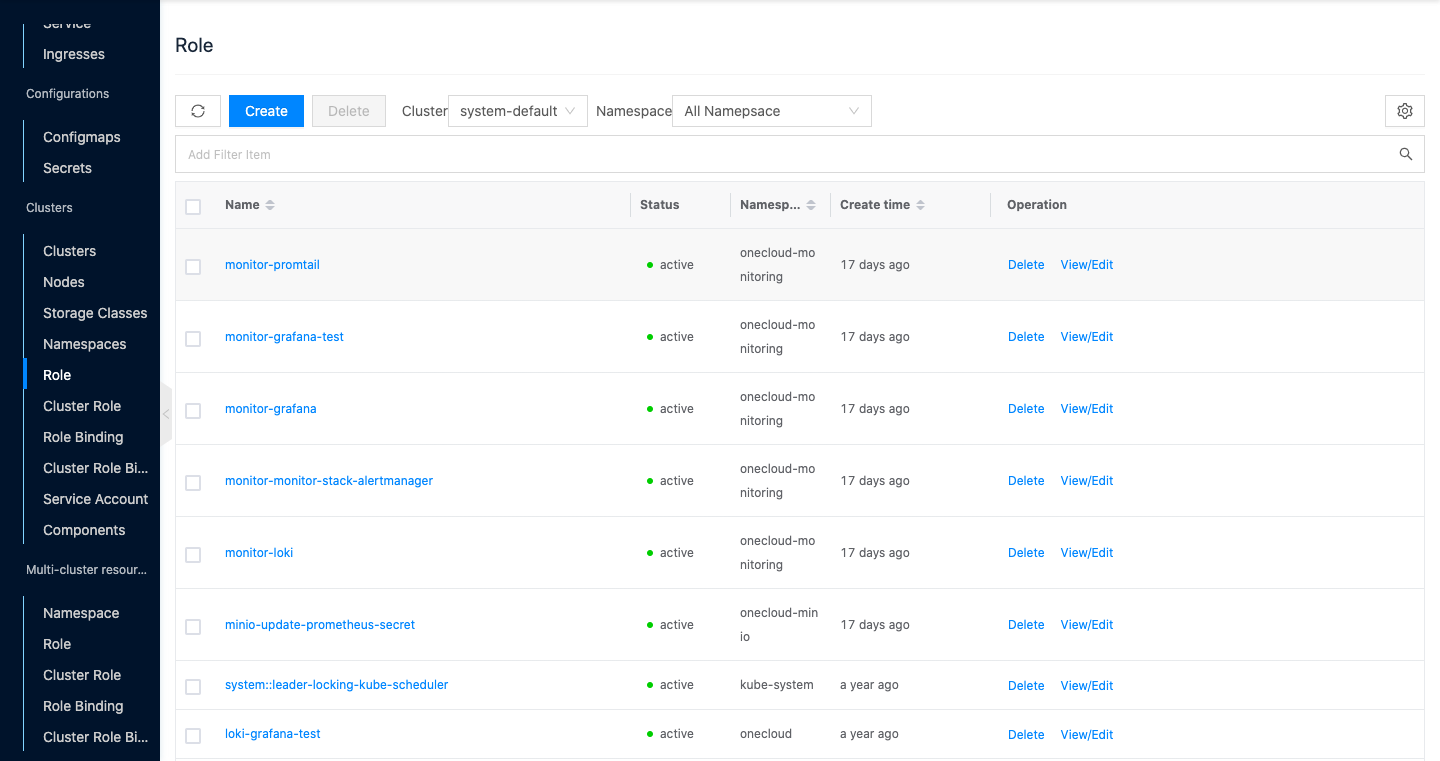Role
A role defines permissions to resources in a specified namespace, and controls access to service accounts by binding them to service accounts.
Please see Kubernetes Official Documentation - RBAC for more details on roles.
Entry: In the cloud management platform click the top left corner of  navigation menu, and click “Containers/Clusters/Roles” menu item in the left menu bar that pops up to enter the roles page.
navigation menu, and click “Containers/Clusters/Roles” menu item in the left menu bar that pops up to enter the roles page.

View Roles
This function is used to filter role information based on clusters and namespaces.
-
In the roles page, by default, you can view the role information of all namespaces under a cluster.
-
When there are multiple clusters in the environment, click the input box on the right side of the cluster at the top of the list and select other clusters to view the role information of all the namespaces under other clusters.
-
When there are multiple namespaces under the cluster, click the input box on the right side of the namespace above the list, select the namespace, and view the role information under the specified namespace.

Create role
This function is used to create roles and authorize them.
- On the Roles page, click the “Create” button at the top of the list to enter the Create Role page.
- Configure the following parameters.
- Name: Set the name of the role.
- Cluster: Select the cluster to which the role belongs.
- Namespace: Select the namespace to which the role belongs.
- Resource Authorization: Click the “Add Resource” button to select the resource and set the permissions to the resource.
- Click the “Create” button to complete the operation.
Delete Role
This function is used to delete a role.
Delete
- On the role page, click the “Delete” button in the action column to the right of the role, and the action confirmation dialog box pops up.
- Click the “OK” button to delete the role and related resources.
Batch Delete
- Select one or more roles in the role list, and click the “Delete” button at the top of the list to bring up the action confirmation dialog.
- Click the “OK” button to delete the role and its related resources.
View/Edit
This function is used to view or edit the role’s yaml file.
- On the role page, click the “View/Edit” button on the right action bar of the role to bring up the View/Update dialog box.
- Support viewing and editing the role’s yaml file information.
- After editing the yaml file, click the “OK” button to take effect.
View Role Details
This function is used to view role-related information.
- On the role page, click the role name item to enter the role details page.
- View the following information: Cloud ID, ID, name, status, domain, project, cluster, namespace, created at, updated at, notes, etc.
View Rules
This function is used to view the rules matched by the role and supports deleting rules.
- On the Role page, click the role name item to enter the role details page.
- Click the “Rules” tab to enter the rules page.
- View the rule information of the role.
- Click the “Delete” button in the action column on the right side of the role to bring up the action confirmation dialog box.
- Click the “OK” button to complete the operation.
View Source Information
This function is used to view and edit the role’s yaml information.
- On the role page, click the role name item to enter the role details page.
- Click the “Source Information” tab to enter the source information page.
- Click the “Copy Content” button to copy the yaml file information of the node.
- After updating the yaml file, click the “Update” button.
View Operation Log
This function is used to view the operation logs related to roles.
- On the Role page, click the role name item to enter the role details page.
- Click the Operation Log tab to enter the Operation Log page.
- Load More Logs: In the Operation Logs page, the list shows 20 operation logs by default. To view more operation logs, click the “Load More” button to get more logs.
- View Log Details: Click the “View” button on the right column of the operation log to view the log details. Copy details are supported.
- View logs of specified time period: If you want to view the operation logs of a certain time period, set the specific date in the start date and end date at the top right of the list to query the log information of the specified time period.
- Export logs: Currently, only the logs displayed on this page are supported to be exported. Click the upper-right corner of
 icon, set the export data column in the pop-up export data dialog, and click the “OK” button to export the logs.
icon, set the export data column in the pop-up export data dialog, and click the “OK” button to export the logs.